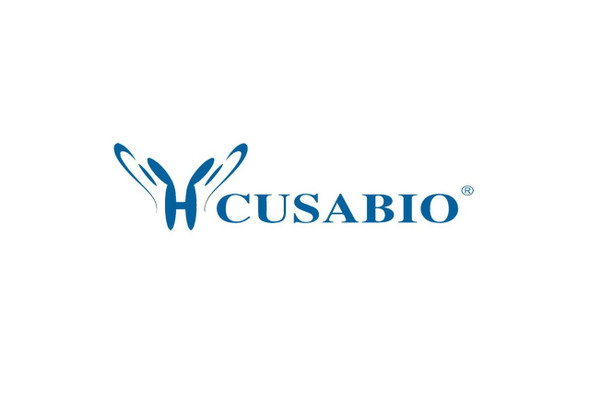Cusabio Human Recombinants
Recombinant Human Zona pellucida sperm-binding protein 3 (ZP3), partial | CSB-RP145354h
- SKU:
- CSB-RP145354h
- Availability:
- 13 - 23 Working Days
Description
Recombinant Human Zona pellucida sperm-binding protein 3 (ZP3), partial | CSB-RP145354h | Cusabio
Alternative Name(s): Sperm receptorZP3A/ZP3BZona pellucida glycoprotein 3 ;Zp-3Zona pellucida protein C
Gene Names: ZP3
Research Areas: Developmental Biology
Organism: Homo sapiens (Human)
AA Sequence: QPLWLLQGGASHPETSVQPVLVECQEATLMVMVSKDLFGTGKLIRAADLTLGPEACEPLVSMDTEDVVRFEVGLHECGNSMQVTDDALVYSTFLLHDPRPVGNLSIVRTNRAEIPIECRYPRQGNVSSQAILPTWLPFRTTVFSEEKLTFSLRLMEENWNAEKRSPTFHLGDAAHLQAEIHTGSHVPLRLFVDHCVATPTPDQNASPYHTIVDFHGCLVDGLTDASSAFKVPRPGPDTLQFTVDVFHFANDSRNMIYITCHLKVTLAEQDPDELNKACSFSKPSNSWFPVEGSADICQCCNKGDCGTPSHSRRQPHVMSQWSRS
Source: E.coli
Tag Info: N-terminal GST-tagged
Expression Region: 23-346aa
Sequence Info: Partial
MW: 63 kDa
Purity: Greater than 90% as determined by SDS-PAGE.
Relevance: The mammalian zona pellucida, which mediates species-specific sperm binding, induction of the acrosome reaction and prevents post-fertilization polyspermy, is composed of three to four glycoproteins, ZP1, ZP2, ZP3, and ZP4. ZP3 is essential for sperm binding and zona matrix formation.
Reference: The DNA sequence of human chromosome 7.Hillier L.W., Fulton R.S., Fulton L.A., Graves T.A., Pepin K.H., Wagner-McPherson C., Layman D., Maas J., Jaeger S., Walker R., Wylie K., Sekhon M., Becker M.C., O'Laughlin M.D., Schaller M.E., Fewell G.A., Delehaunty K.D., Miner T.L. , Nash W.E., Cordes M., Du H., Sun H., Edwards J., Bradshaw-Cordum H., Ali J., Andrews S., Isak A., Vanbrunt A., Nguyen C., Du F., Lamar B., Courtney L., Kalicki J., Ozersky P., Bielicki L., Scott K., Holmes A., Harkins R., Harris A., Strong C.M., Hou S., Tomlinson C., Dauphin-Kohlberg S., Kozlowicz-Reilly A., Leonard S., Rohlfing T., Rock S.M., Tin-Wollam A.-M., Abbott A., Minx P., Maupin R., Strowmatt C., Latreille P., Miller N., Johnson D., Murray J., Woessner J.P., Wendl M.C., Yang S.-P., Schultz B.R., Wallis J.W., Spieth J., Bieri T.A., Nelson J.O., Berkowicz N., Wohldmann P.E., Cook L.L., Hickenbotham M.T., Eldred J., Williams D., Bedell J.A., Mardis E.R., Clifton S.W., Chissoe S.L., Marra M.A., Raymond C., Haugen E., Gillett W., Zhou Y., James R., Phelps K., Iadanoto S., Bubb K., Simms E., Levy R., Clendenning J., Kaul R., Kent W.J., Furey T.S., Baertsch R.A., Brent M.R., Keibler E., Flicek P., Bork P., Suyama M., Bailey J.A., Portnoy M.E., Torrents D., Chinwalla A.T., Gish W.R., Eddy S.R., McPherson J.D., Olson M.V., Eichler E.E., Green E.D., Waterston R.H., Wilson R.K.Nature 424:157-164(2003)
Storage: The shelf life is related to many factors, storage state, buffer ingredients, storage temperature and the stability of the protein itself. Generally, the shelf life of liquid form is 6 months at -20?/-80?. The shelf life of lyophilized form is 12 months at -20?/-80?.
Notes: Repeated freezing and thawing is not recommended. Store working aliquots at 4? for up to one week.
Function: The mammalian zona pellucida, which mediates species-specific sperm binding, induction of the acrosome reaction and prevents post-fertilization polyspermy, is composed of three to four glycoproteins, ZP1, ZP2, ZP3, and ZP4. ZP3 is essential for sperm binding and zona matrix formation.
Involvement in disease: Oocyte maturation defect 3 (OOMD3)
Subcellular Location: Processed zona pellucida sperm-binding protein 3: Secreted, extracellular space, extracellular matrix
Protein Families: ZP domain family, ZPC subfamily
Tissue Specificity: Oocytes.
Paythway:
Form: Liquid or Lyophilized powder
Buffer: If the delivery form is liquid, the default storage buffer is Tris/PBS-based buffer, 5%-50% glycerol. If the delivery form is lyophilized powder, the buffer before lyophilization is Tris/PBS-based buffer, 6% Trehalose, pH 8.0.
Reconstitution: We recommend that this vial be briefly centrifuged prior to opening to bring the contents to the bottom. Please reconstitute protein in deionized sterile water to a concentration of 0.1-1.0 mg/mL.We recommend to add 5-50% of glycerol (final concentration) and aliquot for long-term storage at -20?/-80?. Our default final concentration of glycerol is 50%. Customers could use it as reference.
Uniprot ID: P21754
HGNC Database Link: HGNC
UniGene Database Link: UniGene
KEGG Database Link: KEGG
STRING Database Link: STRING
OMIM Database Link: OMIM









